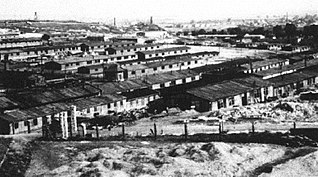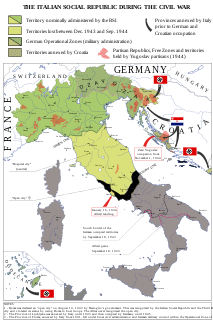
Camp Westerbork was a Nazi transit camp in Drenthe province, northeastern Netherlands, during World War II. It was used as a staging location for sending Jews to concentration camps elsewhere.

Płaszów or Kraków-Płaszów was a Nazi concentration camp operated by the SS in Płaszów, a southern suburb of Kraków, in the General Governorate of German-occupied Poland. Most of the prisoners were Polish Jews who were targeted for destruction by Nazi Germany during the Holocaust. Many prisoners died because of executions, forced labor, and the poor conditions in the camp. The camp was evacuated in January 1945, before the Red Army's liberation of the area on 20 January.

Cuneo is a city and comune in Piedmont, Northern Italy, the capital of the province of Cuneo, the fourth largest of Italy’s provinces by area.

Drancy internment camp was an assembly and detention camp for confining Jews who were later deported to the extermination camps during the German occupation of France during World War II. Originally conceived and built as a modernist urban community under the name La Cité de la Muette, it was located in Drancy, a northeastern suburb of Paris, France.

The issue of why the Allies did not act on early reports of atrocities in the Auschwitz concentration camp by destroying it or its railways by air during World War II has been a subject of controversy since the late 1970s. Brought to public attention by a 1978 article from historian David Wyman, it has been described by Michael Berenbaum as "a moral question emblematic of the Allied response to the plight of the Jews during the Holocaust", and whether or not the Allies had the requisite knowledge and the technical capability to act continues to be explored by historians. The U.S. government followed the military's strong advice to always keep the defeat of Germany the paramount objective, and refused to tolerate outside civilian advice regarding alternative military operations. No major American Jewish organizations recommended bombing.

Borgo San Dalmazzo is a comune (municipality) in the Province of Cuneo in the Italian region Piedmont, located about 80 kilometres (50 mi) south of Turin and about 8 kilometres (5 mi) southwest of Cuneo.

Numerous internment camps and concentration camps were located in France before, during and after World War II. Beside the camps created during World War I to intern German, Austrian and Ottoman civilian prisoners, the Third Republic (1871–1940) opened various internment camps for the Spanish refugees fleeing the Spanish Civil War (1936–1939). Following the prohibition of the French Communist Party (PCF) by the government of Édouard Daladier, they were used to detain communist political prisoners. The Third Republic also interned German anti-Nazis.

Holocaust trains were railway transports run by the Deutsche Reichsbahn national railway system under the control of Nazi Germany and its allies, for the purpose of forcible deportation of the Jews, as well as other victims of the Holocaust, to the Nazi concentration, forced labour, and extermination camps.
Don Raimondo Viale was an Italian Catholic priest, whose name is entered among the Righteous Among the Nations at Yad Vashem for his work on behalf of the Jews during the Holocaust.
Delegation for the Assistance of Jewish Emigrants or DELASEM, was an Italian and Jewish resistance organization that worked in Italy between 1939 and 1947. It is estimated that during World War II, DELASEM was able to distribute more than $1,200,000 in aid, of which nearly $900,000 came from outside Italy.
This is a timeline of deportations of French Jews to Nazi extermination camps in German-occupied Europe during World War II. The overall total of Jews deported from France is a minimum of 75,721.

The Holocaust in France was the persecution, deportation, and annihilation of Jews and Roma between 1940 and 1944 in occupied France, metropolitan Vichy France, and in Vichy-controlled French North Africa, during World War II. The persecution began in 1940, and culminated in deportations of Jews from France to Nazi concentration camps in Nazi Germany and Nazi-occupied Poland. The deportation started in 1942 and lasted until July 1944. Of the 340,000 Jews living in metropolitan/continental France in 1940, more than 75,000 were deported to death camps, where about 72,500 were murdered. The government of Vichy France and the French police organized and implemented the roundups of Jews. Although most deported Jews were killed, the survival rate of the Jewish population in France was up to 75%, which is one of the highest survival rates in Europe.

The Fossoli camp was an internment camp in Italy, established during World War II and located in the village Fossoli, Carpi, Emilia-Romagna. It began as a prisoner of war camp in 1942, later being a Jewish concentration camp, then a police and transit camp, a labour collection centre for Germany and, finally, a refugee camp, before closing in 1970.

Beaune-la-Rolande internment camp was an internment and transit camp for Jews, operated by the French Police under Nazi supervision, located in Beaune-la-Rolande, north of the Demarcation line of occupied France during World War II.

The Holocaust in Italy was the persecution, deportation, and murder of Jews between 1943 and 1945 in the Italian Social Republic, the part of the Kingdom of Italy occupied by Nazi Germany after the Italian surrender on September 8, 1943, during World War II.

Two of the three Axis powers of World War II—Nazi Germany and their Fascist Italian allies—committed war crimes in the Kingdom of Italy.

Karl Friedrich Titho was a Germany military officer, who as commander of the Fossoli di Carpi and Bolzano Transit Camps oversaw the Cibeno Massacre in 1944. Titho was jailed in the Netherlands after World War II for other war crimes committed there, released in 1953, and then deported to Germany. Despite an arrest warrant in Italy in 1954 Titho was never extradited to stand trial for his actions in Italy, and died in Germany in 2001, confessing and repenting his role in the atrocities just days before his death.
The RSI Police Order No. 5 was an order issued on 30 November 1943 in the Italian Social Republic to the Italian police in German-occupied northern Italy to arrest all Jews except those born of mixed marriages, which were required to be monitored by the police.

The Memoriale della Shoah is a Holocaust memorial at the Milano Centrale railway station commemorating the Jewish prisoners deported from there during the Holocaust in Italy. Jewish prisoners from the San Vittore Prison, Milan, were taken from there to a secret underground platform, Platform 21, to be loaded on freight cars and taken on Holocaust trains to extermination camps, either directly or via other transit camps. Twenty trains and up to 1,200 Jewish prisoners left Milan in this fashion to be murdered, predominantly at Auschwitz.














